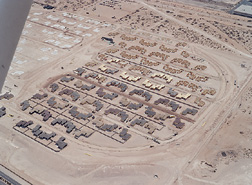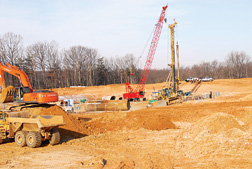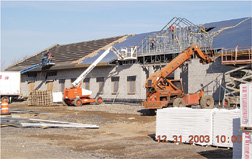...competition and may not be appropriately applied to the procurement of major construction projects.” A Corps spokesman says that the procurement has been reinstated.
The Corps also is moving headlong into modularized construction. Industry sources say the approach is not favored by the Air Force, Navy and some Army commanders. Temple says modular units are not the trailers of old and are used where they allow firms to meet performance specifications, which includes a goal to complete projects at 15% less cost and 30% less time, he notes. The Corps is moving to reduce energy use by 30% in structures and to achieve a LEED Silver sustainability rating. Sources say some subs have major learning curves in using sustainable materials and methods.
 HSMM |
 Army Corps Of Engineers |
 Army Corps Of Engineers |
 Army Corps Of Engineers Other signs of progress: (from top) New Complex At Ohio’s Wright Patterson Air Base; Fort Bliss; Texas, Footprint; Site Work For New Federal Agency At Fort Belvoir and Fort Drum, N.Y., Batallion Headquarters. |
Also somewhat controversial is how the Corps plans to use—and mandate—building information modeling (BIM). Some executives believe the service may require a platform offered by Bentley Systems Inc., Exton, Pa., but worry over implementation costs for small firms and compatibility issues. Temple says the Corps is considering the Bentley program “and other tools to determine the best compatibility among industry, the Corps and our garrisons.” He speculates that implementation by 2009 will depend “on what our experience shows us.”
The Naval Facilities Engineering Command (NAVFAC) is ramping up resources for family housing contracts this year as it supports the Marine Corps’ “Grow the Force” initiative. With plans to add up to 27,000 additional marines in coming years, the need for more bachelor quarters looms. NAVFAC could nearly triple contracting as barracks funding is to increase from $357 million in fiscal 2008 to $1.1 billion in 2009.
NAVFAC Executive Director Steve Iselin reports success with use of public-private partnerships to fund family housing construction in recent years but is not sure if the approach will work for on-base barracks. “It’s a pay-me-now-or-pay-me-later debate,” Iselin says. “With both options, we end up with a bill. The services in the past would have discounted looking at PPP for other facility types, but we’re giving it consideration.”
NAVFAC also is finalizing ways to streamline contracting and delivery methods. Joe Gott, assistant commander for capital improvement and NAVFAC chief engineer, says that in the last two years the Navy has focused on streamlining the design-build process.
Still, Iselin admits drawing bids on larger projects in overheated markets has been an enormous challenge. “We’re at a point where we are several years into that process and we’re saying it might not have been the right approach for every acquisition,” he says. “We found in markets that are overheated, those contractors who can bid on multiple-award contracts are at capacity with work outside the Navy. We’ve seen difficulty with getting good prices in some markets. As we go forward, we’ll look at all options.”
| DOD Construction Programs Get Boost Fiscal Year Budget Requests in $ bil. | |||
| Fiscal 2009 | Fiscal 2008 | % change | |
| Army MILCON | 4.6 | 3.9 | 16.4 |
| Navy MILCON (including U.S. Marines) | 3.1 | 2.2 | 17.3 |
| Air Force MILCON | 0.9 | 1.2 | 40.9 |
| DOD MILCON* | 1.8 | 1.6 | -18.6 |
| BRAC Portion | 9.1 | 7.2 | 10.8 |
| Total MILCON Request | 24.4 | 21 | 25.3 |
*Includes work for DOD-wide agencies and commands | |||
In the near term, NAVFAC is analyzing market conditions more closely, including working with the Corps of Engineers to avoid project competition. Gott says the Navy is trying to give contractors a clear target by being more open about project budget estimates. “We want to eliminate their risk when putting bids together,” he says. But NAVFAC is not yet clear how BIM will fit into its process.
Among key projects on the NAVFAC horizon is realignment of Walter Reed Army Medical Center in Washington, D.C. The current plan, which is part of BRAC, calls for relocation of its services to the National Naval Medical Center in Bethesda, Md. and to a new $747-million hospital at Fort Belvoir, Va.
While firms worry about labor needs to meet the deluge of projects, Corps contracting officials are working 60-hour weeks or more to move work into the industry. “As this matures, everyone will get better at it,” says Neal Wright, Virginia Beach, Va.- based vice president and military programs director for engineer Hayes, Seay, Mattern and Mattern.


Post a comment to this article
Report Abusive Comment